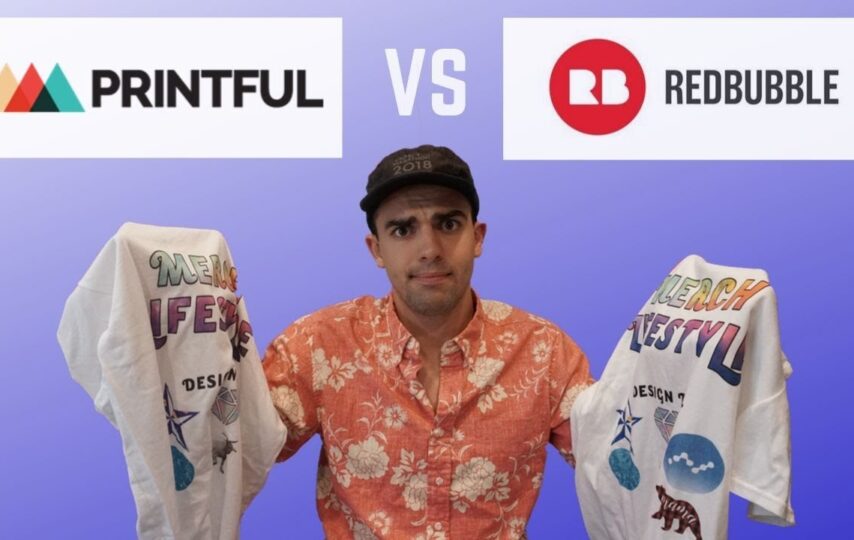The advent of the internet has given rise to a global online marketplace that enables various players to sell and buy goods and services remotely. One such player is the print on demand products that allow people to submit their products’ artworks for printing on demand. The companies receive a user’s artwork placed as an order online and print the same in single or small quantities. This online marketing space has seen the emergence of many stiffly competing companies on the print on the demand front, among them being printful vs redbubble. These two companies are direct competitors with several similarities and differences.
Printful
The company’s name is a coinage from two words, ‘Print Product’ and ‘Fulfilment Service.’ The firm is a print-on-demand platform giving the ability to create and link custom-designed products for sale via your online store. The business is preferred by content creators, brands, and influencers as it allows them to ship products straight to buyers from the company’s warehouse. The products are available for shipping once payment for the order is complete. Some of these products are hats, shirts, hoodies, and blankets. An extra offer comes in the form of fulfillment and warehousing services that give you the chance to store your ordered products in the company’s warehouse upon printing.
Redbubble
Redbubble is an Australian global online marketplace company specializing in selling its members’ submitted artworks inform of decorations on various products. Some of the major products are skirts, prints, hoodies, duvet covers, T-shirts, scarves, leggings, phone cases, cushions, stickers, mugs, caps, bags, and much more. The company is also known for granting free membership to artists who have copyrights to their work, determines their prices, and states the products that may carry their images on display. Your company’s online store gets to display up to 60 varied products on sale, and global shipping is a facilitation of the company, making sure your goods get to customers irrespective of their location. Something unique with Redbubble is that it has a TV series (RBTV) that goes a long way in educating its customers about the platform.
Similarities of Redbubble and Printful
As much as the two companies have glaring differences, there are a few similarities that tie them together like, both are print-on-demand platforms that are easy to use. Further, there are no charges in the form of setup fees by both companies, and the shippingof their products is only on active business days. Both firms support their business activities through Google Analytics. Furthermore, the two companies have a uniform formula for the retail price, the seller price + the base price. Apart from both having an excellent driven customer support system, they levy the cost of shipping the products. The two companies share the beauty of offering warehouse storage services and personal user platforms for the products. Both firms deal in almost all similar products with few differentiations and are direct competitors in the global online market place.
Differences Between Printful and Redbubble
- Even though both firms have a similar retail price formula, Printful uses a fixed base price while Redbubble’s keeps fluctuating.
- Printful offers an opportunity of making orders and storing them in your warehouse. Redbubble has only the option of processing orders by buyers.
- Printful has an elaborate communication system by offering phone, live chat, email, and support tickets. On the other hand, Redbubble has support tickets, guides, and Twitter support.
- Redbubble has its support system anchored on a built-in analytics tool, while Printful has no such built-in analytics tool for its operations.
- The system of levying shipping charges is a point of divergence. Redbubble charges buyers directly for the shipping services, while Printful, on the other hand, charges sellers for shipping, and the sellers can choose to impose a levy on buyers in turn.
- Redbubble is directly involved in the determination of the shipping cost. Printful, on the other hand, grants you the opportunity of setting the shipping cost.
- Printful scores considerably in offering personalized branding to its users, while Redbubble has no such branding offers.
- Redbubble is available and accessible as an online marketplace, while Printful specializes in integrating various eCommerce platforms with online marketplaces. Simply put, you can order from anywhere using Printful, while Redbubble limits you to order from their website.
- In cases of shipping of samples, Printful offers free services. Redbubble, though, has a cost to the shipping of the specimen.
- Redbubble allows you to set a markup price on all your items or distinct categories of products, while Printful offers considerable flexibility with pricing.
The Pros of Printful
The company has an incredibly intuitive user interface that offers a near-on effortless start, an easy API set up, and a mock-up generator. It is easy to process refunds for damaged and lost parcels, and there is an availability of separate warehouse, design, and fulfillment services. The company has a 20% off price offer on sample products. Company website accessibility is easy due to the existing Printful app for both Android and IOS services.
The Cons of Printful
The flexibility of editing multiple products is non-existent, and the company is very pricey with the starting price. There is a restriction on the shipment of framed canvases and posters to specific locations. Perhaps the most limiting aspect of Printful is the inability to process customer refunds for wrongly placed orders in terms of size or colors.
The Pros of Redbubble
The company runs monthly retargeting ads that ensure high customer traffic to its site. Apart from the editing ability of multiple products at one go, the company has plenty of support guides for its current and potential users.
The Cons of Redbubble
The company’s constant product price fluctuations require sustained modification of retail prices. The receipt of earnings takes up to a month. It gets challenging to get clients to notice you due to the company’s absence in eCommerce platform integrations. There is a restriction to product branding, and packaging and product pricing vary in light and dark fabrics.








